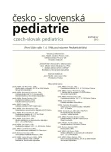Diagnosis and management of pediatric cataract
Authors:
N. Jirásková; J. Kadlecová; P. Rozsíval; M. Kalfeřtová; M. Burova
Authors‘ workplace:
Oční klinika LF UK a FN, Hradec Králové
přednosta prof. MUDr. P. Rozsíval, CSc.
Published in:
Čes-slov Pediat 2012; 67 (Suppl 1): 25-28.
Category:
Original Papers
Overview
Purpose:
To present our results of surgical management of pediatric cataract. To draw attention to seriousness of this topic, necessity of early diagnosis and comprehensive management of pediatric cataract.
Patients and methods:
The patients were divided into two groups according to the etiology of the cataract: congenital, infantile or juvenile cataract (A) and traumatic cataract (B). There were 14 children in group A (8 girls and 6 boys). Cataract was diagnosed during congenital cataract screening in newborns in one child, later during childhood (range 14–132 months, median 43 months) in 13 cases. Group B comprised of 12 children (4 girls and 8 boys). The reason for cataract was penetrating injury in 7 eyes and blunt injury in 5 eyes. All surgeries were performed by experienced surgeon in general anesthesia and were followed by visual rehabilitation and amblyopia treatment.
Results:
No serious perioperative or early postoperative complications were observed. The most common late postoperative complication was secondary cataract (posterior capsule opacification) in 15 patients. Postoperative best corrected visual acuity (BCVA) ranged from 1.0 (normal vision) to 0.002 (low vision) depending upon other ocular pathologies.
Conclusions:
Pediatric cataract remains a challenge despite of all improvements. The management plan must involve an interdisciplinary team approach.
Key words:
pediatric cataract, congenital, posttraumatic, management
Sources
1. Baráková D, Hložánek M. Nové postupy v léčbě dětské katarakty. In: Rozsíval P, et al. Trendy soudobé oftalmologie 5. Praha: Galén, 2008: 119–143.
2. Forbes BJ, Guo S. Update on the surgical management of pediatric cataracts. J Pediatr Ophthalmol Strabismus 2006; 43: 143–151.
3. Stoll C, Alebik Y, Dott B, Roth MP. Epidemiology of congenital eye malformations in 131,760 consecutive births. Ophthalmic Pediatr Genet 1993; 30: 433–435.
4. Wilson ME, Bluestein EC, Wang X-H. Current trends in the use of intraocular lenses in children. J Cataract Refract Surg 1994; 20: 579–583.
5. Wilson ME, Bartholomew LR, Trivedi RH. Pediatric cataract surgery and intraocular lens implantation. J Cataract Refract Surg 2003; 29: 1811–1820.
6. Kuchynka P, Továrek L. Onemocnění čočky. In: Rozsíval P, et al. Oční lékařství. Praha: Galén, 2006: 219–232.
7. Wilson ME, Trivedi RH. Choice of intraocular lens for pediatric cataract surgery: survey of AAPOS members. J Cataract Refract Surg 2007; 33: 1666–1668.
Labels
Neonatology Paediatrics General practitioner for children and adolescentsArticle was published in
Czech-Slovak Pediatrics

2012 Issue Suppl 1
Most read in this issue
- Diagnosis and management of pediatric cataract
- Foreign body in the gastrointestinal tract – a case report and current diagnostic and therapeutic recommendations
- ECMO (Extracorporeal Membrane Oxygenation) in the therapy of respiration and circulation failure in newborns and children
- The folic acid and neural tube defects – from past to present
